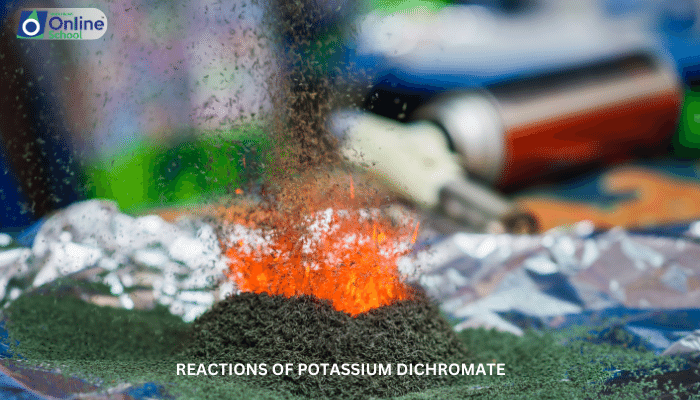
Learning Outcomes:
i. Define potassium dichromate (K2Cr2O7) and its chemical formula.
ii. Describe the physical properties of potassium dichromate, including its color, solubility, and hygroscopicity.
iii. Explain the oxidizing nature of potassium dichromate and its role in redox reactions.
iv. Analyze the reactions of potassium dichromate with oxalic acid and Mohr's salt, writing balanced chemical equations.
v. Identify the practical applications of potassium dichromate in various fields, such as analytical chemistry and textile dyeing.
Introduction
Potassium dichromate (K2Cr2O7), a bright orange crystalline compound, is a versatile and important reagent in chemistry. Its oxidizing properties make it valuable in various applications, including analytical chemistry, textile dyeing, and wood preservation. In this lesson, we will delve into the reactions of potassium dichromate, focusing on its reactions with oxalic acid and Mohr's salt, and explore its practical applications.
i. Physical Properties of Potassium Dichromate
Potassium dichromate exhibits distinctive physical properties:
Color: Potassium dichromate is a bright orange crystalline solid, often appearing as needle-like crystals.
Solubility: Potassium dichromate is highly soluble in water, forming a yellow or orange solution. The solubility increases with temperature.
Hygroscopicity: Potassium dichromate is deliquescent, meaning it readily absorbs moisture from the air and becomes a liquid solution.
ii. Oxidizing Nature of Potassium Dichromate
Potassium dichromate is a strong oxidizing agent, meaning it readily gains electrons by oxidizing other compounds. This oxidizing ability is due to the presence of chromium in the +6 oxidation state, which is highly unstable and tends to lose electrons to attain a more stable lower oxidation state.
In redox reactions, potassium dichromate acts as an electron acceptor, reducing itself to chromium(III) ions (Cr3+). The reduction of potassium dichromate is accompanied by a color change from orange to green.
iii. Reactions of Potassium Dichromate
Potassium dichromate undergoes various reactions, demonstrating its versatility as a reagent. Two notable reactions include:
Reaction with Oxalic Acid: Potassium dichromate reacts with oxalic acid (H2C2O4) in an acidic solution, resulting in the oxidation of oxalic acid to carbon dioxide (CO2) and water (H2O). The reaction is accompanied by a color change from orange to green.
Reaction with Mohr's Salt (FeSO4(NH4)2SO4∗6H2O): Potassium dichromate reacts with Mohr's salt (ferrous ammonium sulfate) in an acidic solution, oxidizing ferrous ions (Fe2+) to ferric ions (Fe3+). The reaction is accompanied by a color change from pale green to dark green.
iv. Practical Applications of Potassium Dichromate
Potassium dichromate finds applications in various fields:
Analytical Chemistry: Potassium dichromate is used as a titrant in volumetric analysis, particularly for the determination of iron(II) ions.
Textile Dyeing: Potassium dichromate is used as a mordant in textile dyeing, helping to fix dyes onto fabrics.
Wood Preservation: Potassium dichromate is used as a wood preservative to protect against fungal decay and insect infestation.
Potassium dichromate, with its oxidizing properties and versatility, plays a significant role in various fields. Its reactions, such as those with oxalic acid and Mohr's salt, demonstrate its practical applications in analytical chemistry, textile dyeing, and wood preservation. Understanding the chemistry of potassium dichromate provides a deeper insight into the diverse applications of this important compound.